Vale Juniors
Football had learned its lessons from WW1, and in WW2 all national league and cup competitions were suspended for the duration. Like many other smaller clubs the Vale had been through this 25 years before and well understood that they had to take their future, indeed their survival, into their own hands. They acted immediately.
In December 1939 they stepped back down a level from Senior to Junior, joining the Central League in place of Springfield Athletic who had just become defunct. Surprisingly, perhaps, especially in view of the war-time circumstances, the vote to admit them to the Central League was just about as close as it could be. On 13th January 1940 Vale of Leven played their first game as a Junior team in a Central League match against Vale of Clyde at Millburn. The crowd of 1,500 was excellent for a Junior game in January in war-time and they got an entertaining match to watch, which the Vale won 5-3. A good start had been made at the Junior level, which is of course where the Vale continues to play until this day.
There were many changes in personnel from just a few months before, most brought on by wartime conditions. For instance, Match Secretary James Forrest had joined the forces and in his place was Alex Galbraith, 13 years later March Secretary of the Junior Cup-winning side. Because of restrictions with wartime travel, all but 2 of the players were local lads, and the playing squad in 1940 included:
Robert Barrie, Barteloni, Willie Findlay, Dan Clancey, John Maule, Jim Murray, J Curley, Archie Taylor, I McRae, John Blair, McClure.
Stepping down to the Juniors was the best thing that the Vale could possibly have done. It positioned them to play at a level which matched their economic and playing resources, and allowed them to regularly draw in crowds of 1,000+ in the post-war period. That in turn attracted good players to the Club and in 1947 the Vale won the Evening Times Central League Championship. The big prize was, of course, the Scottish Junior Cup, a notoriously difficult Cup to win.
Scottish Junior Cup Winners
However, the Vale had built up an excellent back-room staff, led since 1941 by President Hugh Craig, who was also a County Councillor in Alexandria. By 1951, Hugh had seen enough to realise that a wee bit of tweaking to the organisation would help their on-field performance and he proposed that a single person rather than the Match Committee of 5-7 people should be managing the team. He convinced his management committee to appoint Alex Galbraith as Match Secretary, which was a common but inappropriate title because he was in fact the manager of the team.
This was an inspired choice. Although Alex’s father and his brother played for the Vale, and his two sisters played hockey for Vale FPs, Alex himself was happy to admit that he had never played for anyone. No matter, within 2 seasons Alex had built a formidable team which was a mixture of many talents. In fact most of the players did not come from the Vale, but that did not matter, they certainly played for the Vale. By season 1952 – 53 it looked as if that team might achieve something in the next few years, although with a notable exception nobody seems to have expected it to be in 1953. If urban myth is true, and it probably is in this case, that exception was Charlie Stewart, who became the newsagent in Bridge Square. It is said and was widely believed that Charlie backed the Vale to win the Cup before the season started and continued to back them with his winnings in every round, making enough money in the process to buy the shop. We can only hope that this story is true – it’s too good not to be.
There must have been times in the Vale’s march to the Hampden Final that Charlie’s heart was in his mouth, but maybe less so as they progressed through the rounds. By the time they got to the semi-final game you had to be a true believer or thought that they had run out of luck because they were drawn against the much fancied pride of Glasgow, Ashfield. The semi-final game was played on Saturday evening 2nd May 1953 at Ibrox Park. Special trains had taken a large Vale contingent to the old Ibrox Station, and this swelled the crowd to 33,000. In fact, the game turned out to be much easier for the Vale than expected. They never gave Ashfield time to settle, and a hat-trick from their talisman, centre-forward Willie Cassidy saw the Vale run out 3-0 winners. This was in addition to the 2 goals which he had scored in the quarter-final win over Dunbar United by 2-0 at Millburn, which can be seen on the Lovely Valley video. Crowds waited at the Fountain for the return of the officials and the few local players – a mild foretaste of what was to come.
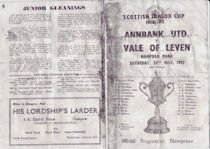
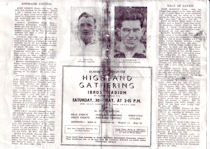
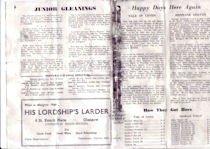
Images of the 1953 Scottish Junior Cup Final Program - Vale of Leven vs Annbank United
Click Images to Enlarge
Annbank United, the Vale’s opponents in the final, were in fact favourites to win the Cup. They had a big strong team – bigger man for man than the Vale – they were a very good passing side, and they had perfected the offside-trap en route to the final. The Hampden crowd was variously put at 53,000 and 56,000, but in any event the Vale and Dumbarton were pretty well empty of people on that Saturday afternoon, May 23rd 1953. The Vale team was exactly the same as the one which had beaten Ashfield 3 weeks before
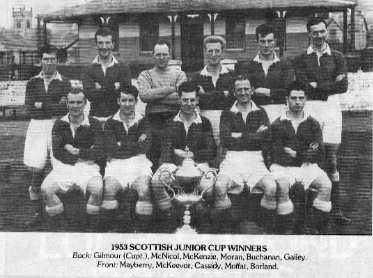
Chummy Gilmour (capt); J McNicol; John McKenzie, Jimmy Moran, Maurice Buchanan and Willie Gailey;
Alex Mayberry, Frank McKeevor, Willie Cassidy, Jackie Moffat, and John Borland.
Match Secretary: Alex Galbraith, Trainer Gordon Conway.
Strangely enough the referee was the same person who refereed the Vale’s semi-final against Ashfield - EH Youngson of Aberdeen.
Truth to tell, the crowd didn’t see a very good game, partly because the Vale didn’t play particularly well, but mainly because of the negative off-side tactics of Annbank. They were springing the trap almost on the half-way line and the crowd were not impressed. Both sides missed chances, but with ten minutes to go, who else but Willie Cassidy scored with a fine left-foot shot. The Vale managed to see out the last 10 minutes and then the party began.
Win or lose, arrangements were already in place for a procession through Renton and Alexandria and a Civic Reception in the District Council headquarters in the Gilmour Institute in Gilmour Street. The team bus stopped at the Renton War Memorial, at that time out at the Howgate, where the Renton Pipe Band fell in and led it and the entourage of following coaches through the streets of Renton, lined with cheering crowds. At Burnbrae, Bonhill Parish Pipe Band, still the reigning Cowal Champions, fell in ahead of Renton Pipe Band and took over leadership of the procession. By this stage the Main Street had crowds on both sides, but progress was quite easy. The nearer they got to the Fountain, however, the thicker the crowds were and from Mitchell Street / Overtoun Street to Gilmour Street it was a real struggle for the police to keep a passage-way clear. Tom Glen was busy taking still photos and Charlie Wingate was equally busy taking cine-film, which was made into a film about the Vale and the Coronation and shown at the Strand. The output from both of these sources shows quite clearly the density of the crowd. The police estimated that in the area of the Fountain and Gilmour Street there were 7,000 people, so when you include Renton and the rest of Main Street Alexandria, just about the whole of the Vale had turned out to welcome the returning heroes.
The additional bonus was that the Queen’s Coronation was taking place just a few weeks later, and there were already many street decorations and floodlights erected in preparation for that. It could not have been a better setting for the celebrations. The Fountain and the Gilmour Institute were floodlit, and a nice touch was provided by the Admiralty as dusk approached – they turned on the Torpedo Factory’s Coronation floodlights and illuminations in honour of the Vale’s success. After the Civic Reception the team also took the Cup on a tour of the Vale before returning it to the Gilmour Institute for safe keeping. That was a very long and happy Saturday night in the Vale.
A full photographic record of the Cup Final can be found on the Vale Junior’s excellent web-site. The same Pictures drop-down menu contains Former Players which gives a very good pictorial record of the1960’s – 1990’s Vale teams.
In fact the Vale only held the cup for another 5 months because in a third round second replay against Clydebank at Boghead on 28th November 1953, they lost 2-1. The losing team showed only a couple of changes from the one which had won the Cup Final. It was:
McKenzie, Gilmour and Muir; Moran, Buchanan and Gailey; Mayberry, Joyce, Cassidy, Moffat and Borland.
The official attendance for this game was 14,000 which was almost certainly way off the mark. Most people who were there, be they Sons of the Rock, Bankies or Jeelie-Eaters put the attendance at over 20,000 and this game is unofficially regarded as the ground record for Boghead Park.
Although the Cup season was over for the Vale, honours still came the way of the players. Cassidy and Mayberry were selected to play for Junior Scotland and Moran, Gilmour and Gailey were reserves.
The next season’s AGM was held at the end of the season in April 1954, in a packed Susannah Street Schoolroom. It was a positive and enthusiastic affair, and no wonder. The Cup win of the previous year and the 3 games against Clydebank in the current season had left the Vale in a very good financial position, probably for the first time in the 20th century. This had allowed the Club to complete the installation of electricity at Millburn. The funds were also used for ground improvements during the next year, because by April 1955 the Club could report that training flood-lights had been installed and the new covered enclosure which could accommodate 1,200 was nearing completion. All these measures would be paid for by funds already in the bank, and the Club was debt-free.
At that April AGM one significant change in the back-room team was made. Alex Galbraith stood down as Match Secretary after 4 successful years in that job, and Andy Melville was elected to replace him. Andy had been performing a similar role for the high-flying Vale of Leven Academy FP’s, of whom more below. Alex was elected as Vice President of the Club, with Hugh Craig continuing as President.
That was that for the Scottish Junior Cup. Although the Vale was well supported for the rest of the 1950’s and early 1960’s, and although they had many good teams and fine players, they have not so far rediscovered that winning formula for the Scottish Junior Cup. But this year or next could be the year. That’s what keeps us all turning up at football matches – the triumph of hope over experience.
The Vale of Leven Academy Former Pupils Football Club – The Vale FP’s
However, its not the last time that a Vale team played in a final at Hampden – that honour falls to the Vale of Leven Academy Former Pupils (the Vale FP’s) who got to the final of the Scottish Amateur Cup in 1956, where they met Milanda. While the FP Football Club had been on the go since early in the 20th century, by the 1950’s and 60’s it had become a great Vale institution with a group of players, officials and supporters at large who seem to have come straight from Hollywood’s Central Casting. Most of them have gone on to lighten and brighten many of the Vale’s Clubs, some in leading roles others by their wit and humour. The FP’s Club was a happy place to be, full of good people; some of them were even good footballers, in spite of what they say now, and all of whom “got stuck in” for the cause. This was true not only of the players, it was equally true of the capable and enthusiastic officials, prominent amongst whom were the likes of Andy Melville, David Thompson, John Barr, Jim Currie, and big Jimmy Rodger, who usually ran the line.
Typical of the spirit of the group is the time that they found themselves in Glasgow with a player missing and the game only minutes away from kick off. Big Jimmy quietly slipped away and bought himself a pair of football boots. He came back to announce he would play “oot on the wing, I’m usually there wi a flag anyway and you guys’ll never know’ the difference .” Unfortunately there’s no recollection of how well the spare football strip fitted Jimmy, but you can imagine it might just have been a picture to savour. Anyhow, the opposition were none the wiser, the FPs got the result they wanted and Jimmy retired as a player with a perfect playing record.
In the spring of 1956 they fought their way to the final of their premier competition – the Scottish Amateur Cup.
As soon as they got there, the club had to pull out a few stops to be able to field its strongest team on the day. Billy Oliver had just been called up to do his National Service and was stationed down is Oswestry. The Vale FP Match Secretary, David Thompson, best known as the referee of the latter stages of the Russell Cup, wrote to Billy’s commanding officer to ask that he be given leave for the final. He duly agreed and Billy could play.
The first game in the Final 1956 was played on Saturday 28th April 1956 at Hampden. The Vale team was:
Cameron McKee, R Brannan, Archie McDonald; Billy Oliver, George Crawford, Hamish McColl; Johnny Wood, Jackie McMillan, Davie Docherty, Stan Jones, Bobby McKinlay.
Hampden that day was no place for the faint hearted as tackles and shoulder charges flew in, with frequent stoppages for fouls and injuries. One of these injuries in the second half was to the Vale keeper Cameron McKee who broke his collar bone and had to be taken off mid way through the second half. In those days, of course, no substitutes were allowed and the Vale were down to 10 men. Bobby McKinlay moved from the wing to take over as goal-keeper. Those who knew Bobby will know that this didn’t faze him one little bit – one report called his goal-keeping “unorthodox” which was probably a perfect description – and he gave little away.
When Stan Jones was carried off on a stretcher Vale were down to 9 men and looking like a lost cause. With 5 minutes to go, Milanda scored and the Cup looked long gone. Then in true Roy of the Rovers style, Stan reappeared from the treatment room and with only a few minutes left Vale resumed the attack. Probably the smallest person on the park, John Woods, perfectly timed his header of a Jackie McMillan cross to give 10 men Vale a deserved equaliser. Normal time ended at 1-1 and although extra time was played that was the way game finished. Vale supporters thought the Vale would have won with 11 men, and were unlucky not to win even with just 10, but that’s football.
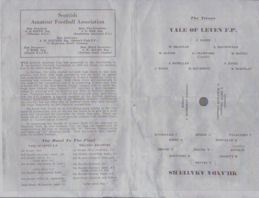
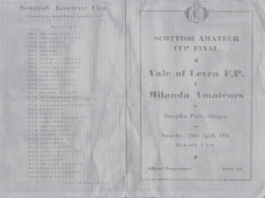
Images of the 1956 Scottish Amateur Cup Final program
Vale of Leven Academy FP vs Milanda
Click Images to Enlarge
The resulting replay was not played for another 3 weeks on the evening of Saturday 19th May 1956, before a crowd of 3,000. Graham Aitken replaced the injured Cameron McKee, and Billy Oliver again got leave to play. The game was exciting enough, but the Vale could not quite match Milanda. Again the Vale were reduced to 10 men when Stan Jones was sent off for an incident in which he was the victim. But there was to be no happy outcome. Even although Milanda missed 2 penalties they ended comfortable 3-1 winners and the FPs went home empty handed.
The FP club played on for another 20 years or so, and there were many more characters and good players to come, many of whom like Benny McAlpine (“the best wee keeper in the West”; no make that “the World”) and Ian “Straw” Miller, would fill a book all on their own. Their tale is well worth telling and we will tackle it in the second instalment of the story of Football in the Vale.
Renton Thistle in the 1920’s
Renton Thistle Football Club was founded in the first flush of new Vale football clubs, in 1873. It co-existed with 2 other Renton football clubs at that time and went on to outlast all of them. We have to thank Billy and Christine Livingstone for this photo of a Renton Thistle team of 1926, displaying a cup which they had won. In 1926 Renton Thistle were playing in the Vale District League against other locals teams such as Bonhill Athletic, St Martin’s Boys Guild, St Agnes’ Boys Guild who came down from Glasgow to play in the league, Bonhill Union, Young Emmett, Bonhill Celtic, Renton Boys Guild, and Renton Victoria, the team for which the great Alex Jackson and his brother had played.
They competed in the Scottish Secondary Cup, but lost, so it is not that trophy which appears in the photo. So far, we have been unable to find any reference to them winning a cup in 1926, but it’s possible that the cup is actually for winning the league – a flag wouldn’t have been a great deal of use to these clubs. However the search for the Cup’s name will continue.
On the other hand, and unlike most photos of that vintage, we do have the names of everyone in the photo. The line-up is as follows:
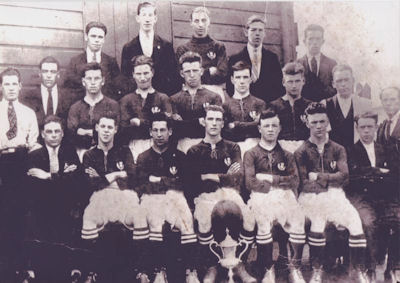
Renton Thistle 1926 - Click Image to Enlarge
Back Row: R McLeod, R Davies, W Kennedy, J.Folan, D Brown
Middle Row: J Bell, P Folan, T Lamont, R.Law, W Chalmers, T Wrethman, J.Moore, R Smith, J McLure
Front Row: J Beaton, Bunty Mills, A McDermid, A Henderson, H Duffy, R Livingstone, T Mulholland
R Livingstone is Billy’s grandfather, and was lost when HMS Hood was sunk by the Bismarck in May 1941. Bunty Mills’ Christian name was Hugh and he was Willie Mills’ brother – Willlie played for Scotland and Aberdeen in the 1930’s. Hugh later not only won the Powderhall Sprint, but also signed for West Ham.
Football Clubs in the Vale of Leven 1872 - 1890
A measure of just how popular football became in the Vale and surrounding areas in the period immediately after the founding of Vale of Leven Football and Athletic Club is the number of other clubs which were formed, and the number of different locations in which these clubs found pitches on which to play. Some of them became quite successful for a short time playing in the Scottish Cup, but not quite competing with the mighty Vale and Renton. Others such as Jamestown and Renton Victoria were very good at unearthing young talent which they supplied to Vale, Renton and clubs further afield. Quite a few survived into the 20th century, but only Renton Thistle and Renton Victoria of this list of smaller clubs, survived in continuous existence into the 1920’s. A host of other clubs emerged, of course, in the 20th century, playing at different levels to take their place in the Vale football spectrum. The 19th century clubs included:
Alexandria Cricket Club. Formed 1877 disbanded about 1879. Colours in 1877 blue and white striped jerseys, white knickers. Ground Football and Cricket Park, Balloch Road, Alexandria
Bonhill. Formed 1884. Colours in 1885 light blue jerseys and white knickers. Ground in 1888, Croft Loan Park
Jamestown. Formed 1877. Colours (1878) navy blue jersey, white knickers and black stockings. 1888 white jersey, blue knickers. Ground (1878), Private Park, Balloch Road
Kilmaronock Thistle. Formed 1874, struck off SFA roll 26.8.1884. Colours 1878 red jersey, blue knickers with red stripe and red hose. Ground 1877 Ross Lane Park in Gartocharn village.
Levendale. Formed 1879 Colours 1884 blue jersey and hose white knickers. Ground 1884 Private Park Balloch Road, 1890’s the Institute Park (i.e. the Public Park), Alexandria.
Renton FC. Formed 1872, struck off SFA roll 1881, re-admitted to SFA 22 August 1882, disbanded 1921. Colours 1876, red and white stripe. 1886 blue jersey and blue knickers with red stripe. Grounds: 1876 private Park at north end of Renton village. 1877 South Park. 1878 Tontine Park
Renton Thistle. Formed 1873. Colours 1876 blue jerseys white knickers and red hose. Ground (1876) south end of Renton village.
Star of Leven. Formed 1873 struck off roll 24.8.1882. Colours 1876 red jersey white knickers blue hose. Ground 1877 public Park Bridge Street Alexandria
Vale of Leven FC. Formed 1872. Colours Dark blue jerseys and knickers, red stocking. Ground 1872, Cameron’s Park. By 1876 North Street Park. 1888 Millburn Park
Vale of Leven Hibernians. Two clubs appeared at slightly different times under this name. We’re not sure when the first of them was first formed, but it was admitted to the SFA on 20.9.1881, but was struck off 2.6.1883. Colours 1881 dark green jerseys, blue knickers, red hose. Ground 1881 Private Park, Bridge Street Alexandria
A club with the same name re-formed in 1885 and was admitted to SFA on 24.8.1886. Colours in 1886 were: white jersey, blue knickers. 1887 green jersey, blue knickers. Ground 1886 Hill Street Park Alexandria.
Vale of Leven Rovers. Formed 1873. Colours 1876 light blue jersey, white knickers, black hose. Ground 1876 Public Park, Alexandria
Vale of Leven Wanderers. Formed 1883, admitted to SFA 21.8.1883. Colours 1884 black and white striped jerseys, blue knickers, black and white striped hose. Grounds 1884: Private park Bridge Street Alexandria, 1887 Balloch Road Park, 1888 Hill Street, Alexandria.
Other local teams
Dumbarton FC. Formed 1872. Colours (1876) dark blue jerseys, white knickers with blue stripe and red hose. 1885 Black and gold vertical striped jerseys, white knickers. Grounds: (1876) Lowman’s Park, Glasgow Road Dumbarton. 1877 Private Park, Townend. (1879) Boghead Park
There were at least 10 other senior clubs in Dumbarton at this time: Albion (formed 1880), Alclutha (1872) which became Dunbritton in 1883, Dumbarton Athletics (1881), Dumbarton Hibernians (1885-1886), Dumbarton Union (1882), Lennox (1873-1882), Methlan or Methlen Park (1887), Rock (1882).Also, Newtown Thistle (1895), was most likely a short-lived Dumbarton club.
Helensburgh. Formed 1874. Struck off SFA roll 22.8.1882, re-admitted 25.8.1885, struck off 24.8.1886, not sure when it was re-admitted but it wasn’t out of the SFA for very long. Colours (1876) blue and yellow jersey and knickers, black hose. (1885) Blue jersey, white knickers. Grounds (1876) Ardenconnel Park (1877) Kirkmichael Park, Old Luss Road. (1885) Mossend. Helensburgh survived until well into the 20th century, and were for a period a Senior Club. They were leaders of the Scottish League’s Third Division when it collapsed in 1926 and but for that collapse would have been promoted into the Second Division where they would surely have survived for even longer. For all their efforts over 50 years or so they deserved a better fate than that.
There were 2 other Helensburgh teams from this period. Helensburgh Union which was in existence around 1895 and probably earlier, and Victoria (1878).
Sources
As has been said, there already is a great deal of information in different types of media in the public domain about football in the Vale. The main sources used in this article are:
- John Weir – “The Boys from Leven’s Winding Shore, A History of Vale of Leven Football Club”, published in the late 1980’s by The Scottish Football Historian, 43 Lady Nairn Avenue, Kirkcaldy, Fife KY1 2AW, priced £4.95 plus 60p postage. It is still in print and is the last word about the Vale FC 1872 – 1900. It also provides a great deal of information about other teams in Dunbartonshire in the early days of Scottish football.
- Temple & Ferguson – “The Old Vale and Its Memories” (1927) which is very good on the 1870’s players and their subsequent socialising in the form of the Old Vale Team annual re-unions, and the follow-up “Epilogue” from the same 2 authors, which provides some additional information about the players.
- Vale of Leven Juniors FC’s excellent web-site at www.valeoflevenfc.co.uk to which has recently been added many photos from the 1950’s onwards, although you do have to go down a couple of search levels to find them.
- The SFA is to be congratulated – not words you hear every day – for the homage which they pay to the Vale in the early section of the Scottish Football Museum at Hampden Park, which is well worth a visit in its own right. See the SFA web-site for details of opening hours, times of stadium tours, charges etc.
- Allan McLean - History of Vale Cup Ties 1873 – 1922, written by a man who saw many of them and was for many years President of the Club.
- B Boyle & R James – The Russell Cup, the definitive account of the primary school competition in the old West Dunbartonshire. It was written by two weel-kent Vale men Benjie Boyle and Ronnie James who took it into their heads to produce a full account of the competition, and probably exceeded their own best expectations. The team photographs are a joy for generations of Vale folk and a not-to-be-missed opportunity to embarrass your father and grandfather.
- There are probably 20 – 30 other good sources in print and on web-sites, and many others whose contents have to be treated with a great deal of caution, but are right on some things of interest. In print, you cannot do better than rely on anything by the late and much-missed Bob Crampsey (Queen’s Park wins every argument against the Vale of course). Ged O’Brien’s recently published (2010) “Played in Glasgow” is magisterial on all the sports, not just football, which have been played in Glasgow, and helps explain the early venues of Vale’s matches against Queen’s, Third Lanark and Rangers. It’s a strongly recommended read for all sports fans. “Football League Tables 1888 – 2006” edited by Michael Robinson is very helpful on the Vale and Renton’s early league performances. As ever, the Evening Times “Wee Red Book” is the bible on Scottish Internationalists, international results and cup finals, while Douglas Lanning’s “A Scottish Internationalists Who’s Who 1872-1986” fills in many of the details.
- Other relevant web-sites include Scottish-football-historical-archive.com, historicalkits.co.uk, and the Wikipedia entries on Scottish football generally and the Vale in particular.
- Dumbarton Library is also a fund of information, not least in the microfiche copies of the Dumbarton and Lennox Heralds, but also as a holder of many of the books mentioned above. The staff are on hand to help in finding what you are after.


